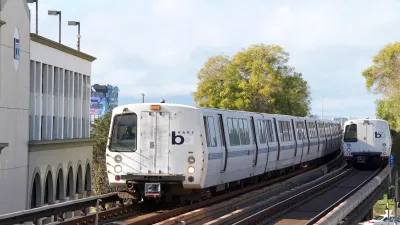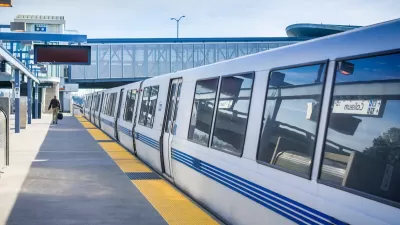Bay Area Rapid Transit, a hugely successful system pre-pandemic, is now struggling to close a massive projected budget gap, with no certain solutions on the table.

Once an agency with the nation’s highest farebox recovery ratio, San Francisco’s Bay Area Rapid Transit (BART) system now faces an uncertain future, writes Ricardo Cano in the San Francisco Chronicle.
With ridership remaining low, “In its worst-case scenario, BART would impose mass layoffs, close on weekends, shutter two of its five lines and nine of its 50 stations and run trains as infrequently as once per hour.” Even worse, “Those deep cuts, agency officials say, could lead to the demise of BART.” Cano outlines the system’s current state, noting that BART will run out of federal funding in January 2025, a situation much more severe for agencies like BART that rely heavily on fare revenue. While officials have proposed a variety of potential solutions, there is no long-term plan yet.
Cano points out that “A Bay Area without BART, however unimaginable, would further fragment public transit, worsen traffic congestion on highways and bridges, and erode the natural flow of a region so profoundly shaped by the rail system.”
BART General Manager Bob Powers says the agency has to change its revenue model. “Instead of relying mostly on fares, we must invert our funding formula to rely more heavily on subsidies and a sustainable source of revenue that recognizes ridership recovery will take years.” California transit agencies are asking for a state subsidy, while BART is pushing for a local ballot measure. But according to Cano, “Newsom’s January budget included $2 billion in cuts to transit projects with no subsidy, highlighting the challenges of securing a state bailout.”
FULL STORY: Could the Bay Area lose BART?

Trump Administration Could Effectively End Housing Voucher Program
Federal officials are eyeing major cuts to the Section 8 program that helps millions of low-income households pay rent.

Planetizen Federal Action Tracker
A weekly monitor of how Trump’s orders and actions are impacting planners and planning in America.

Ken Jennings Launches Transit Web Series
The Jeopardy champ wants you to ride public transit.

California Invests Additional $5M in Electric School Buses
The state wants to electrify all of its school bus fleets by 2035.

Austin Launches $2M Homelessness Prevention Fund
A new grant program from the city’s Homeless Strategy Office will fund rental assistance and supportive services.

Alabama School Forestry Initiative Brings Trees to Schoolyards
Trees can improve physical and mental health for students and commnity members.
Urban Design for Planners 1: Software Tools
This six-course series explores essential urban design concepts using open source software and equips planners with the tools they need to participate fully in the urban design process.
Planning for Universal Design
Learn the tools for implementing Universal Design in planning regulations.
Ada County Highway District
Clanton & Associates, Inc.
Jessamine County Fiscal Court
Institute for Housing and Urban Development Studies (IHS)
City of Grandview
Harvard GSD Executive Education
Toledo-Lucas County Plan Commissions
Salt Lake City
NYU Wagner Graduate School of Public Service





























